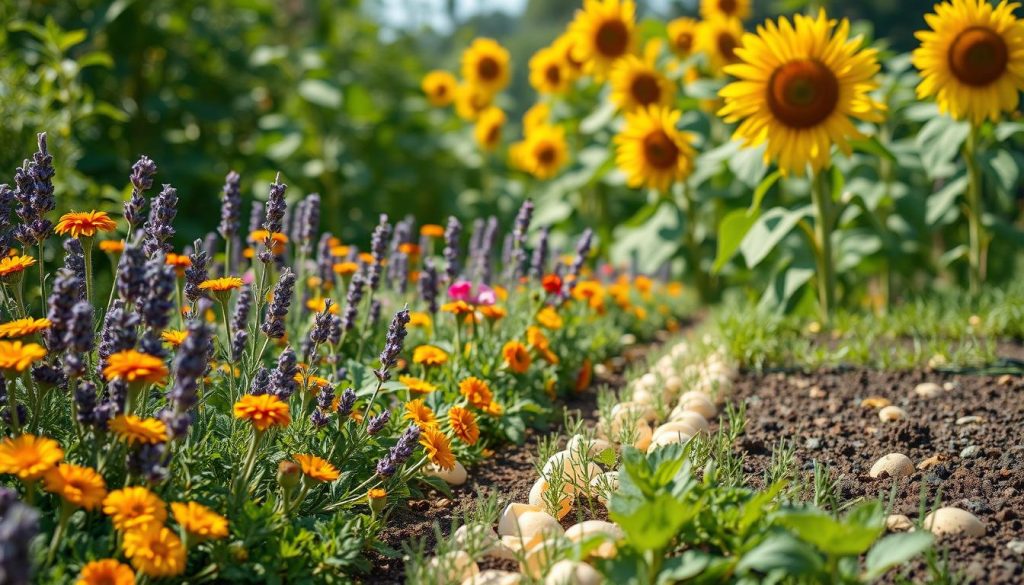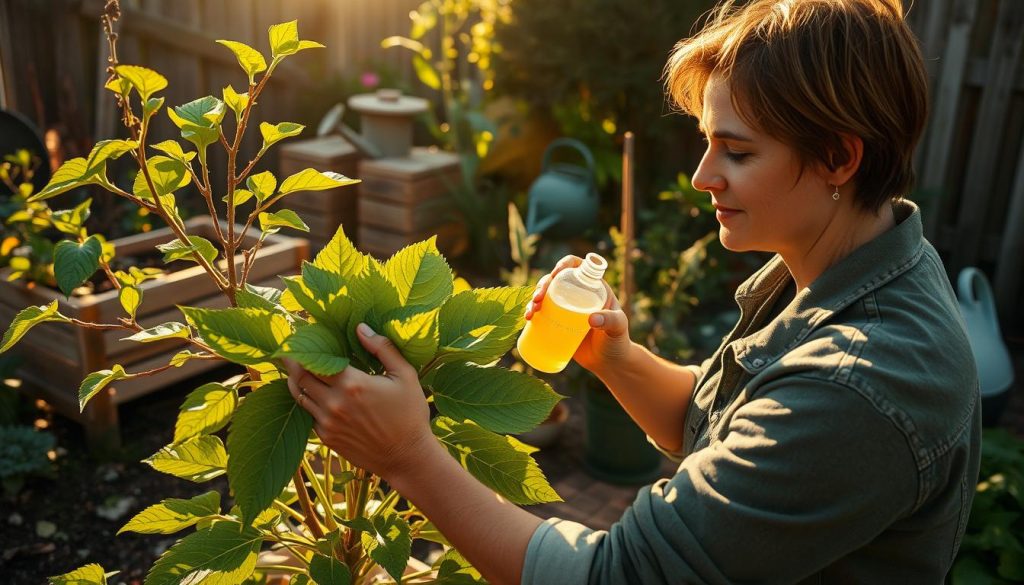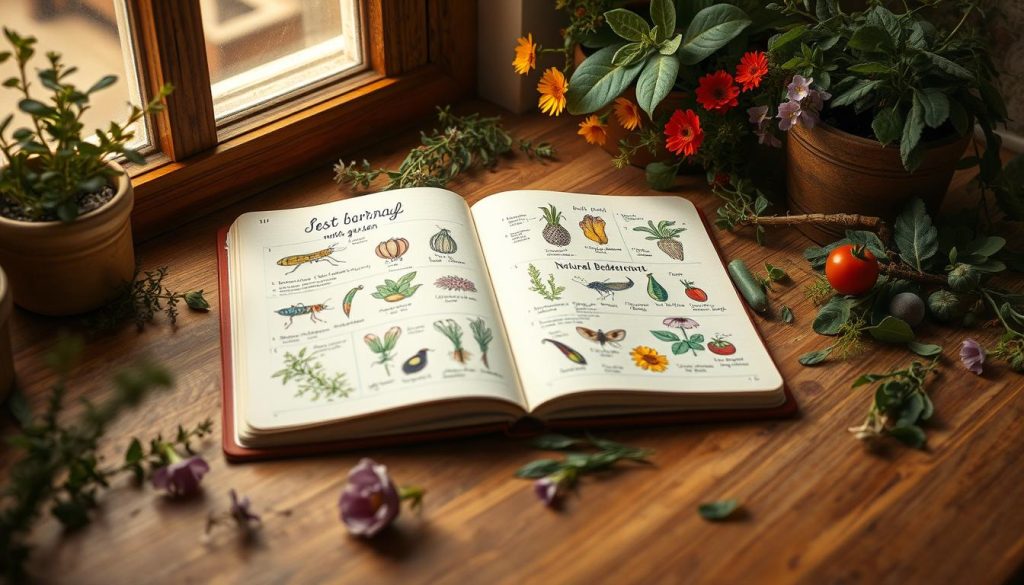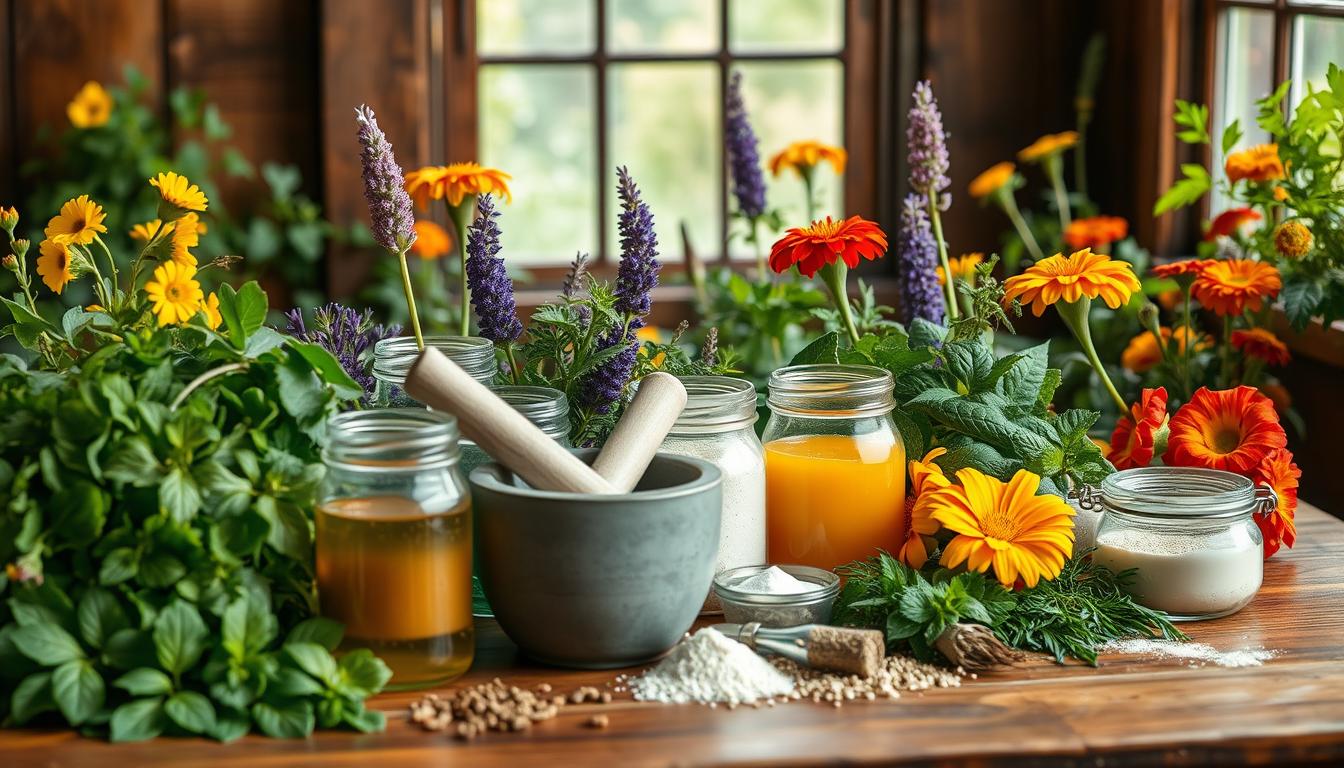Seeing your plants get eaten by pests is really sad. Many people don’t like using chemical pesticides because they worry about their health and the planet. They also don’t want to harm the good bugs in their garden.
But, you can make your own safe pest killers. These homemade solutions are great at fighting off pests. They also keep your garden safe for kids, pets, and bees.
Organic pest control is easy and uses things you might already have at home. You can mix vinegar, soap, spices, and plant oils to protect your plants. These simple ingredients can make a big difference.
In this guide, we’ll show you how to make pest-fighting solutions. You’ll learn how to spot pests early and pick the best natural remedy. These methods are perfect for both new and experienced gardeners. They help your plants grow strong and healthy.
The Hidden Dangers of Commercial Pesticides
Many gardeners use commercial pesticides without knowing the risks. These chemicals can harm their health, pets, and the environment. It’s important to understand these dangers to choose safer options.
Health Risks to Humans and Pets
Commercial pesticides can harm us through skin contact, breathing, or eating them. Even a little exposure can cause headaches, dizziness, and breathing problems. Kids and pets are at high risk because they play in treated areas and might eat residues.
Long-term use of these pesticides can lead to serious health issues. These include hormone problems, brain issues, and some cancers. The American Academy of Pediatrics says kids are extra sensitive to these chemicals during important growth times.
Environmental Impact on Beneficial Insects
Most commercial pesticides harm both bad and good insects. When you spray, you kill pests and also hurt pollinators like bees and butterflies. These insects are key for plants to make seeds.
Helpful insects like ladybugs and praying mantises keep pest numbers down. But, broad-spectrum pesticides kill these helpers. This makes you need to use more chemicals to keep pests away.
Chemical Residue in Homegrown Food
Growing your own food is great for getting fresher, healthier food. But, pesticides can leave harmful residues on your veggies and fruits. These chemicals don’t just wash off with water.
Even if you follow the instructions, these chemicals can stay in the soil for a long time. This is a big problem for gardens where you grow food. Using non-toxic pest repellents is a safer choice.
Why DIY Natural Pesticides Are the Better Alternative
Natural pesticides made at home are a game-changer for garden care. They outdo commercial options in many ways. By choosing homemade solutions, you protect your plants and help the environment while saving money.
These natural options let you control what touches your plants and soil. It’s a healthier choice for your garden.

Eco-Friendly and Biodegradable Benefits
Natural pest control breaks down quickly, unlike chemical pesticides. This means they don’t harm the environment for years. They’re safe for groundwater and wildlife.
Using natural solutions means working with nature, not against it. They keep good bugs like bees and ladybugs safe. Many gardeners see more pollinators after switching to natural methods.
The ingredients in DIY pesticides, like garlic and hot peppers, feed your soil as they break down. This improves soil health while controlling pests.
Cost-Effective Garden Solutions
Homemade pesticides save a lot of money. A bottle of commercial organic pesticide costs $15-25 and lasts a month. Homemade versions cost less than $2 and use common kitchen items.
- Annual savings for a small garden: $100-150
- Medium garden savings: $200-300
- Large garden or small farm: $500+ annually
- No special equipment needed—just basic kitchen tools
- Ingredients often serve multiple purposes in cooking and cleaning
DIY pesticides also reduce plant damage and save on replacement plants. They help plants grow stronger, needing less care over time.
Customizable for Specific Pest Problems
DIY solutions are very adaptable. Commercial products are one-size-fits-all, but homemade ones can be tailored to your garden’s needs.
Adjusting Potency for Different Plant Types
Delicate plants need gentler treatment than tough ones. With homemade pesticides, you can adjust the strength. Dilute for seedlings and use stronger mixtures for bigger plants.
This lets you treat different parts of your garden differently. You can even make special formulas for indoor plants that won’t smell up your house.
Targeting Specific Pest Species
Each pest has its own natural repellent. Aphids hate garlic, while slugs don’t like diatomaceous earth. By knowing your pests, you can make targeted solutions that won’t harm good bugs.
This approach is a big change from using harsh chemicals. It creates a balanced garden where good bugs thrive and pests are kept in check. Your garden becomes stronger and more self-sufficient over time.
Essential Ingredients for Your Natural Pest Control Arsenal
Building a strong natural pest control system starts with the right ingredients. These ingredients work well together in your garden. You don’t need rare items or special skills. Many effective pest fighters are probably in your kitchen or garden already.
Common Kitchen Ingredients That Fight Pests
Your kitchen is full of ingredients that can fight pests. Garlic repels aphids, mosquitoes, and beetles with its sulfur compounds. It also stops larger pests from eating your plants.
Hot peppers, like cayenne, have capsaicin. This makes it hard for spider mites and whiteflies to survive. Vinegar, like apple cider vinegar, keeps weeds and ants away when mixed right.
Baking soda makes your plants less likely to get powdery mildew. Dish soap removes the waxy layer on insects, helping to control pests.
Beneficial Garden Plants with Pest-Repelling Properties
Planting the right plants can protect your garden from pests. Marigolds keep nematodes and other pests away with alpha-terthienyl. They also attract good bugs that eat pests.
Nasturtiums lure aphids away from your crops. Aromatic herbs like rosemary, mint, and basil keep pests away. Lavender not only looks good but also keeps fleas and moths away.
Natural Oils and Their Pest-Fighting Capabilities
Plant oils are key to many natural pest control methods. Neem oil stops pests from eating and reproducing without harming good bugs. It’s great against aphids, mealybugs, and scale insects.
Essential oils like peppermint and eucalyptus confuse and repel pests. Cedar oil messes with insect pheromones. Citrus oils, like lemon, dissolve the waxy layer on insects. These oils are safe and break down fast.
5 Powerful DIY Natural Pesticides You Can Make Today
Turn kitchen items and garden plants into pest fighters. These homemade solutions are good for the planet and your wallet. Plus, you probably have most of the stuff already!
Garlic and Hot Pepper Spray Recipe
This mix is a top choice for fighting pests. Garlic and hot peppers repel aphids, spider mites, and caterpillars.
Ingredients and Preparation
You’ll need:
- 4-5 cloves of garlic, minced
- 1-2 hot peppers (jalapeños or cayenne), finely chopped
- 1 tablespoon of vegetable oil
- 1 teaspoon of mild liquid soap
- 1 quart of water
Blend garlic and peppers with a bit of water until smooth. Strain through cheesecloth into a jar. Then, mix in oil, soap, and water. Shake well.
Application Guidelines
Use this spray in the morning or evening. Coat leaves well, where pests hide. Reapply every 5-7 days and after rain. Test on small plants first, as some may react to capsaicin.

Neem Oil Solution
Neem oil comes from the neem tree. It stops insects from reproducing and is safe for most garden helpers.
Mix 2 teaspoons of neem oil, 1 teaspoon of soap, and 1 quart of warm water. The soap helps the oil stick to plants. This mix fights aphids, mealybugs, and scale. Apply every 7-14 days, avoiding hot sun to prevent leaf damage.
Insecticidal Soap and Oil Mixture
This solution kills soft-bodied insects by breaking down their outer layer. To make it:
Blend 1 tablespoon of castile soap, 1 tablespoon of vegetable oil, and 1 quart of water. The soap kills insects, and the oil helps it stick. It’s great for aphids, thrips, and whiteflies. Spray directly on pests, making sure to cover both sides of leaves.
Diatomaceous Earth Applications
Diatomaceous earth (DE) is a powder from ancient sea creatures. It’s a safe choice for organic gardens.
For dry use, dust plants and soil with DE. For wet use, mix 4 tablespoons of DE per gallon of water and spray. DE works best when dry, so reapply after rain. Use food-grade DE and wear a mask to avoid inhaling dust.
Vinegar-Based Weed and Pest Control
Vinegar is great for killing weeds and pests. Mix 1 cup of white vinegar, 1 tablespoon of liquid soap, and 1 gallon of water for a basic solution.
For stronger weed control, use 1 part vinegar to 2 parts water. This is best on young weeds and works best on sunny days. For pests, the basic mix deters ants and other insects. But be careful, as vinegar can harm beneficial insects and damage plants if applied directly.
Targeted Solutions for Common Garden Pests
Different pests need different solutions for organic gardening. Knowing which pest is causing trouble helps use the best organic pest control. Let’s look at strategies for common garden pests.
Aphid Control Strategies
Aphids are tiny sap-suckers that can harm plants. Look for aphids on stems and leaf undersides. They leave behind sticky honeydew residue.
Use a strong water spray to remove aphids. Then, spray with garlic-pepper solution every 5-7 days. Plant flowers like sweet alyssum and dill to attract beneficial insects.
- Neem oil solution (2 tablespoons per gallon of water) works against aphid nymphs
- Introduce ladybugs or lacewings as natural predators
- Companion plant with strongly-scented herbs like mint, garlic, and chives
Combating Caterpillars and Worms
Not all caterpillars are bad. Protect monarch and swallowtail caterpillars. Control cabbage loopers and tomato hornworms.
Use Bacillus thuringiensis (Bt) spray for targeted control. Spray in the evening and reapply after rain.
Deterring Larger Pests: Rabbits and Deer
Physical barriers are best for big pests. Use fencing at least 2 feet high for rabbits and 8 feet high for deer. Bury the bottom to stop digging.
Make natural repellent sprays with garlic, hot pepper, and eggs. These smells repel pests without harming them. Plant deer-resistant plants like lavender and sage around vulnerable areas.
Slug and Snail Management
Slugs and snails can harm seedlings fast. Use copper tape barriers around beds. The copper deters them.
Apply diatomaceous earth around plants for a sharp barrier. Use it after rain or watering. Remove slugs and snails in the morning to control their numbers.
Green pest solutions work best together. Use a mix of strategies like attracting beneficial insects and targeted sprays. This creates a strong garden ecosystem that fights pests naturally.
Seasonal Considerations for Natural Pest Management
The seasons change, and so should your pest control methods. By adjusting your approach, you’ll make your garden more resilient. Eco-friendly pest management is a continuous process that works with nature’s rhythm.
Spring Preventative Treatments
Spring is the best time to prevent pests. Clear away debris where pests might hide. Use compost tea to strengthen young plants and make them pest-resistant.
When it’s warm enough, add beneficial nematodes to your soil. These tiny creatures attack pest larvae. Check leaves often for signs of pests.

Summer Maintenance Strategies
Summer is when pests are most active. Use natural solutions more often. Spray in the morning or evening to avoid evaporation and leaf burn.
After rain, reapply natural pesticides. Use strong-scented herbs like basil and marigolds to confuse pests.
Fall and Winter Preparation
Fall cleanup is key for pest control. Remove spent plants but keep some insect habitats. Use neem oil on perennials before the frost.
Winter is for planning and preparing. Improve soil with compost for spring. Clean and organize your pest control supplies during this quiet season.
| Season | Primary Focus | Key Natural Treatments | Application Frequency |
|---|---|---|---|
| Spring | Prevention | Compost tea, beneficial nematodes | Every 2-3 weeks |
| Summer | Active control | Garlic spray, neem oil, insecticidal soap | Weekly (more after rain) |
| Fall | Cleanup and protection | Neem oil, diatomaceous earth barriers | Monthly |
| Winter | Planning and soil health | Compost amendments, dormant oil sprays | Once before spring |
Proper Storage and Shelf Life of Homemade Pesticides
Many gardeners forget about the importance of storing DIY natural pesticides right. Unlike store-bought products, homemade ones don’t last long. They need special care to stay effective. Storing them correctly can make a big difference.
Container Selection and Labeling
The right container is key for your homemade pesticides. Dark glass bottles are best for most, like those with essential oils. They keep light-sensitive ingredients from spoiling fast.
For water-based solutions, plastic spray bottles are okay for a short time. But, avoid them for concentrated or oil-based formulas. Essential oils can damage plastic.
- Name of the solution and target pests
- Complete list of ingredients
- Date of preparation
- Dilution instructions (if applicable)
- Estimated expiration date
Storage Conditions for Maximum Potency
Keep your homemade pesticides in a cool, dark spot. A shelf in your garden shed or garage is perfect. This helps them stay effective longer.
Temperature changes can weaken them. So, store them away from heaters and windows. For water-based solutions, the fridge can help them last longer. Just remember to let them come to room temperature before use.
Signs That Your Natural Pesticide Has Expired
Even with good storage, homemade pesticides will eventually lose their power. Look out for these signs to know when to make a new batch:
Unusual separation after shaking means the emulsion has broken down. Bad smells, unlike the original, suggest fermentation or bacteria. Color or consistency changes, like darkening or thickening, mean oxidation of the active ingredients.
If you’re unsure, it’s better to make a fresh batch. Most DIY natural pesticides stay good for 1-2 weeks. But, oil-based formulas can last up to a month if stored right.
My Personal Journey with DIY Natural Pesticides
Six years ago, I started using natural pest deterrents in my garden. I wanted to avoid chemicals and learned a lot along the way. My journey has been full of ups and downs, but it’s made my garden better.
Initial Challenges and Learning Curve
My first attempts at making plant-based pesticides didn’t work well. I made a garlic spray that was too weak, and aphids ate my roses. I also made a neem oil solution that left a bad residue because I didn’t mix it right.
Applying the sprays at the wrong time was another problem. I learned that spraying in the hot sun could burn leaves. But spraying in the early morning worked much better.
Keeping a garden journal helped me a lot. It let me track which pest control methods worked best. It took almost a whole growing season to feel confident in my methods.

Surprising Benefits Beyond Pest Control
Using homemade solutions did more than just control pests. My tomatoes, once eaten by hornworms, grew better and tasted sweeter. Friends loved the taste and color of my veggies, thanks to no harsh chemicals.
I also saved a lot of money. I spent 75% less on pest control than before. Plus, making my own solutions was rewarding and made me feel self-sufficient.
Learning about beneficial insects was the best part. I could tell the good bugs from the bad. This knowledge made me a better gardener.
Long-term Results in Garden Health
Using natural pest control for years made my garden much healthier. The biggest changes were in soil quality and beneficial insects.
Improved Soil Quality
Without chemicals, my soil got better. Earthworms increased, making the soil better for plants. My soil became richer and better at holding water.
Stronger plants grew in this soil. They needed less help from me, as they could fight off pests better.
Increased Beneficial Insect Population
Beneficial insects like ladybugs and bees came back to my garden. They helped control pests for free. Pollinators like bees and butterflies also visited more often.
| Aspect | Before Natural Pesticides | After 3 Years | After 6 Years |
|---|---|---|---|
| Pest Pressure | High, recurring infestations | Moderate, manageable | Low, mostly self-regulating |
| Beneficial Insects | Rarely observed | Regular sightings | Abundant, diverse species |
| Soil Quality | Compacted, poor drainage | Improved structure | Rich, crumbly, moisture-retentive |
| Plant Health | Frequent disease issues | Stronger growth | Vigorous, naturally resistant |
| Harvest Quality | Average yield and flavor | Improved taste and quantity | Exceptional flavor, abundant yields |
My journey with natural pest control changed my garden and my view of nature. It started with avoiding chemicals and led to a healthier garden. The early struggles were worth it for the benefits I see today.
Common Myths About Natural Pesticides Debunked
Many gardeners are hesitant to use botanical insecticides because of myths. These myths make them doubt the effectiveness and ease of use of natural pest control. Let’s look at the truth behind these misconceptions and help you on your gardening path.
The Effectiveness Question
One big myth is that natural solutions don’t work as well as chemicals. But research shows this isn’t true. Neem oil and pyrethrin are effective against many garden pests.
Chemicals might work fast, but natural options offer long-term control. Studies show natural pest repellents can be just as good as chemicals over time.
Understanding Proper Application and Expectations
Many people are disappointed with natural pesticides because they’re not used right. Unlike chemicals, natural solutions need more frequent use, like after rain.
It’s also important to use the right amount. Too little can make them less effective. Use the exact recipe and apply at the best times, like early morning or evening, for better results.
When Natural Solutions Might Not Be Enough
Sometimes, natural solutions alone aren’t enough. Severe infestations might need stronger methods first, then natural care.
Pests like squash vine borers or Japanese beetles can be tough for natural methods. Using a mix of non-toxic repellents, physical barriers, and beneficial insects can be more effective than one solution alone.
Embracing a Holistic Approach to Garden Protection
Creating a thriving garden is more than just fighting pests. It’s about creating a balanced ecosystem. Here, plants, insects, and soil work together naturally. Switching to green pest solutions is a big step towards this balance.
Your garden gets stronger when you focus on prevention. Healthy soil grows plants that can fight off pests better. Diverse plants confuse pests and attract helpful insects that keep pests away.
Try companion planting – like marigolds near tomatoes or nasturtiums with cucumbers. These pairings create natural barriers against pests. They are the key to effective organic pest control.
Changing to natural methods takes time. Start by replacing one chemical product with a homemade solution. See how your garden responds and make changes as needed. Each season brings new lessons.
As your garden grows, you’ll see fewer pests and more beneficial insects. Birds will visit more, soil will improve, and your harvests will be safe for your family.
Protecting your garden naturally means more than just growing plants. It’s about nurturing a mini-ecosystem that gets stronger every year. This approach brings more joy than any quick chemical fix, connecting you to nature’s cycles for centuries.

